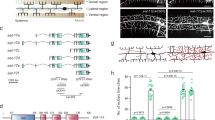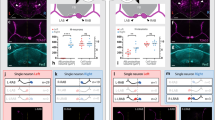Abstract
Pruning is important for sculpting neural circuits, as it removes excessive or inaccurate projections. Here we show that the removal of sensory neuron dendrites during pruning in Drosophila melanogaster is directed by local caspase activity. Suppressing caspase activity prevented dendrite removal, whereas a global activation of caspases within a neuron caused cell death. A new genetically encoded caspase probe revealed that caspase activity is confined to the degenerating dendrites of pruning neurons.
This is a preview of subscription content, access via your institution
Access options
Subscribe to this journal
Receive 12 print issues and online access
$209.00 per year
only $17.42 per issue
Buy this article
- Purchase on SpringerLink
- Instant access to full article PDF
Prices may be subject to local taxes which are calculated during checkout



Similar content being viewed by others
References
Luo, L. & O'Leary, D.M. Annu. Rev. Neurosci. 28, 127–156 (2005).
O'Leary, D.D. & Koester, S.E. Neuron 10, 991–1006 (1993).
Truman, J.W. J. Neurobiol. 21, 1072–1084 (1990).
Watts, R.J., Hoopfer, E.D. & Luo, L. Neuron 38, 871–885 (2003).
Awasaki, T. & Ito, K. Curr. Biol. 14, 668–677 (2004).
Watts, R.J., Schuldiner, O., Perrino, J., Larsen, C. & Luo, L. Curr. Biol. 14, 678–684 (2004).
Grueber, W.B., Jan, L.Y. & Jan, Y.N. Development 129, 2867–2878 (2002).
Williams, D.W. & Truman, J.W. Development 132, 3631–3642 (2005).
Kumar, S. Sci. STKE 2004, pe49 (2004).
Kondo, S. et al. Mol. Cell. Biol. (in the press).
Lazebnik, Y.A. et al. Nature 371, 346–347 (1994).
Lauber, K., Blumenthal, S.G., Waibel, M. & Wesselborg, S. Mol. Cell 14, 277–287 (2004).
Freeman, M.R., Delrow, J., Kim, J., Johnson, E. & Doe, C.Q. Neuron 38, 567–580 (2003).
Awasaki, T. et al. Neuron 50, 855–867 (2006).
Kuo, C.T. et al. Neuron 51, 283–290 (2006).
Acknowledgements
We thank M. Schubiger for helpful discussions; T. Awasaki for informing us about the second site mutation on the draperΔ5 chromosome; E. Baehrecke (University of Maryland Biotechnology Institute, College Park, Maryland), S. Kumar (Hanson Institute and Institute of Medical and Veterinary Science Adelaide, Australia), P. Meier (Institute of Cancer Research, London), W. Grueber (Columbia University, New York), J. Abrams (University of Texas/Southwestern Medical Center, Dallas), W. Johnson (University of Iowa, Iowa City, Iowa), G. Schubiger and S. McNabb (University of Washington, Seattle), M. Freeman (University of Massachusetts Medical School, Worcester, Massachusetts) and the Bloomington Drosophila Stock Center at Indiana University for fly stocks; A. Miyawaki (RIKEN Brain Science Institute, Saitama, Japan) for plasmids; and S. Lennox for technical assistance. Research was supported by grants from the US National Institutes of Health (NS-029971), the Medical Research Council and the CREST program of the Japan Science and Technology Agency.
Author information
Authors and Affiliations
Contributions
D.W.W. designed the study, conducted the experimental work, interpreted the data and wrote the manuscript. A.K. generated the adult viable draperΔ5 chromosome and assisted with experimental work. S.K. designed and built the caspase probe, helped interpret data and assisted in writing the manuscript. Y.H. and J.W.T. contributed to experimental design, data interpretation and writing of the manuscript.
Corresponding author
Ethics declarations
Competing interests
The authors declare no competing financial interests.
Supplementary information
Supplementary Fig. 1
The dendrites of ddaC are pruned by local degeneration. (PDF 632 kb)
Supplementary Fig. 2
The role of caspase activity in ddaC pruning. (PDF 646 kb)
Rights and permissions
About this article
Cite this article
Williams, D., Kondo, S., Krzyzanowska, A. et al. Local caspase activity directs engulfment of dendrites during pruning. Nat Neurosci 9, 1234–1236 (2006). https://doi.org/10.1038/nn1774
Received:
Accepted:
Published:
Issue Date:
DOI: https://doi.org/10.1038/nn1774



